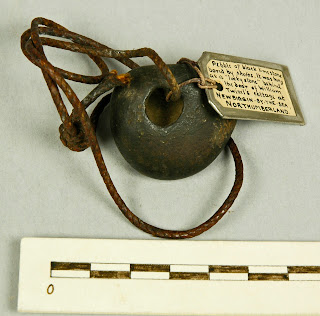A couple of weeks ago, the project team walked the short distance up to
No. 61 Banbury Road, home of the University’s Institute of Social and Cultural
Anthropology (ISCA). We went to attend a student lecture entitled
‘The Self-Management of Misfortune by the Use of Amulets and Charms'. The
speaker was Eric Edwards, whose years as a former gallery attendant and library
assistant at the Museum have endowed him with a passion for, and extensive
knowledge of, its collections.
 |
| 59 and 61 Banbury Road © Roger Templeman |
Eric talked about the ancient origins of amulets as far back as Paleolithic Germany more than 30,000 years ago. He pointed out that although concepts of folklore, religion, superstition and medicine were all useful when talking about amulets, the most important thing to understand is that they are believed to possess magical powers. That belief may be personal or cultural (or both), and is what transforms them from ordinary objects into amulets. They retain this power for as long as people believe in them and, in many cases, are only considered efficacious when held, touched or kept close to the body.
 |
| PRM 1985.51.840: Ammonite pendant in silver mount |
Eric cited the social anthropologist Sir James George Frazer who,
a century ago, attributed the magical powers of amulets to one of two
principles: the laws of similarity and contagion. Amulets working under the law
of similarity use ‘like-for-like’ to imitate cause and effect; for example, in places such as Cambridgeshire and Whitby ammonite fossils were believed to be dead, curled up snakes and were therefore
worn as amulets to protect against adder bites. As such, they
were often known as ‘adder beads’ and ‘snake stones’.
An amulet working under the law of contagion
has once been in contact with another object or person, thereby establishing a
magical link between the two. Obvious examples of this type are the many Christian reliquaries we are finding in the de Mortillet collection, their owners able to
channel reassurance and protection from the tiny fragments of bone, hair
or clothing derived from the saint or holy figure to whom they directed their prayers.
 |
| PRM 1908.11.1: 'Lucky stone', Newbiggin-by-the-Sea, Northumberland |
Finally, there was a potato charm belonging to Harry Hopkins, an
innkeeper in Leighton Buzzard in the late 19th century. Mr Hopkins had carried
the potato in his coat pocket along with three others for nine years as a
cure for rheumatism and had remained free from the condition for all that time. Unfortunately, you won't be able to use those hash browns in your freezer to the same effect; for the charm to work, it was essential for the potato to have been stolen…
Helen




